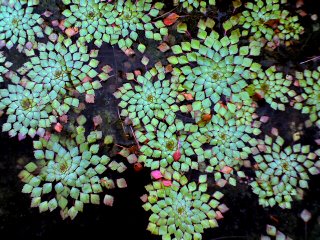Mosaics and reflections
Once in a while I stumble across a confluence of different streams of thought. Here's one example. Not far from our home, in
Inside the glass conservatory are gardens, including a tropical exhibit. The first time I took Mani to this exhibit, he found an imposing rainforest, filled with towering banana plants, fallen trees, strangler figs, murky pools, and hissing jets of steam, and so he wanted to leave as soon as possible. I insisted we take a quick look anyway. He was glad that we did, as we eventually came across a colony of leafcutter ants behind glass. For fifteen minutes the boy was entranced. A crowd of people had also gathered to watch the ants as they carted thumbnail-sized pieces of leaves into the colony. Mani abruptly -- and somewhat randomly -- announced to the crowd: “There is a Twelve helping the ants! She is doing a very good job.”
I should probably explain. In Mani’s world, numbers are invisible, sentient creatures. The odd numbers are male, and the even numbers are female. The numbers range from a One, which sleeps in its own cardboard box by his bed, to the Two, Three, and Five that are the characters in his novel, on up through the Thirteen that’s the size of a truck and the Fifty-Five that’s as big as a house, past the One Hundred and Forty Four that devours planets, and on toward a fearsome and unimaginable Infinity. (Sometimes Mani blasphemously fibs, insisting that he created everything and that in his creation, numbers are finite.)
Once in a while, though, numbers are just numbers to Mani, and not creatures that he imagines scrabbling around like the ants. He recently learned about the Fibonacci sequence of numbers, and immediately began scribbling sums on a scrap of paper. For a few days he was singing a somewhat tuneless song about the sequence, but then all but forgot about it. Only then, when I noticed its absence, did I start to think about it too.
Here’s the confluence: outside the conservatory is a narrow pool that skirts the tropical plants exhibit. Its waters reflect the light reflecting off the glass of the conservatory. On the same day that we found the leafcutter ants, I also found something I had never seen before. In this pool, among the giant water lilies, hibiscus, and papyrus, there were mosaic plants (Ludwigia sedoides), which have red and green diamond-shaped leaves floating in beautiful whorls. In each group of leaves are two sets of spirals going in opposite directions. If you count the number of spirals in each set, the numbers are usually two consecutive numbers in the Fibonacci sequence (this is called Fibonacci phyllotaxis). So there it was: spirals, glass, mosaics, numbers, and nature, all spun together and echoing in front of me. Do I look closer, or do I step back and look from farther away?




0 Comments:
Post a Comment
<< Home